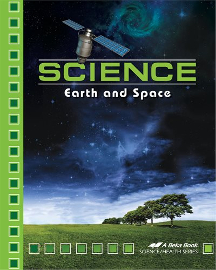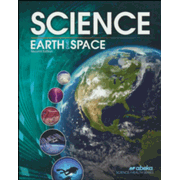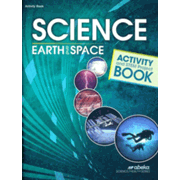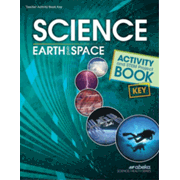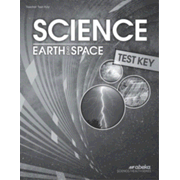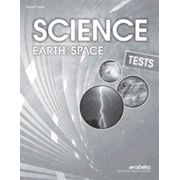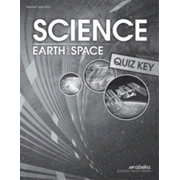Science: Earth and Space is Abeka's eighth-grade science course. The textbook for this course has full-color illustrations, and some hands-on activities are presented within the lessons. While their seventh-grade text, Science: Order & Design, often addresses students directly, this text is written a little more formally, using only the third person.
Lessons are presented in 12 chapters that cover topics such as the characteristics of soil, the structure of the earth, earthquakes, rocks, minerals, weather, erosion, oceans, the atmosphere, water vapor, weather forecasting, the solar system, astronomy, the history of space flight, and environmental science. An entire chapter addresses the origins debate (creation vs. evolution), the flood, the age of the Earth, and the fossil record from a fundamentalist, Protestant point of view.
Chapters are divided into sections, with each section focused on a narrower topic. At the end of each section are “Section Review” questions. These include four or more comprehension questions and, sometimes, one or more “Thought Provoker” questions. The thought questions sometimes just require lengthier answers, but some require students to synthesize the information they have read to come up with answers.
At the end of each chapter, a Chapter Review helps prepare students for a chapter test. Students are given lists of words and terms to define as well as phrases to identify, such as “the top two soil horizons” and “the three primary plant food elements” (p. 27). The extensive glossary at the back of the book might help students with the definitions. Questions in the Chapter Review are presented under the headings of Explain and Apply, but the questions are not distinctly different between the two sections.
You can purchase a textbook answer key that has the answers for both section and chapter questions. Alternatively, you can purchase the two-volume teacher’s edition that surrounds reduced images of the student pages with teaching information, assignments, and answer keys. Within the teaching information are reading quizzes to be presented orally by the teacher; the answers are with the questions. The teacher’s edition alerts you to the experiments that will be done for each lesson, but you must go to the activities themselves to see what will be required.
There are separate quiz and test books for this course, and there are separate answer keys for both the quiz book and the test book.
Hands-On Activities and Call-Out Boxes
Hands-on activities are presented sporadically. There is a flurry of six of them for the first chapter, then only a few or none for the remaining chapters. Some that are presented under the heading “Backyard Scientist” are outdoor observations or activities. “Check It Out” is the heading for informal activities such as observing how food coloring travels up the capillaries of a celery stalk (page 26).
“Science Investigations” are step-by-step experiments that help prepare students for high school lab courses. Science Investigations include their own sets of questions within the textbook. While these experiments sometimes talk about using specific lab equipment, such as beakers and graduated cylinders, household items can be used as substitutes most of the time. However, some activities require equipment such as a kitchen scale and thermometers. (A barometer and a hygrometer are listed for one investigation, but they are optional.)
There are a number of other special call-out boxes throughout the text. “Math Connections” show how math is used in specific scientific applications. “A Closer Look” features in-depth articles on topics such as “The Volcanic Explosivity Index” on page 60 and “Nuclear Accidents” on page 392. “Creation Clip” articles show how creation continually provides evidence of a creator.
Activity and STEM Project Book
The full-color Science: Earth and Space Activity and STEM Project Book has one or more activity sheets for each chapter and instructions for a STEM (Science, Technology, Engineering, Math) project. The activity sheets include multiple-choice questions, crossword puzzles, images to label, and a graphic organizer to complete.
The STEM project has students create a design, develop an application, or investigate a STEM-related topic. The teacher key for the Activity and STEM Project Book has answers for the activity pages plus extensive information for the teacher about the STEM project. Students are supposed to create a logbook, submit a research plan, and write a paper about the project. There should be plenty of material within the rest of the course, so you can decide whether or not you want to assign the STEM project. However, projects are especially effective ways to develop real-world understanding and applications for what students are learning. I would encourage you to try to have students complete one.
Summary
Science: Earth and Space should appeal to Christian families who want to prepare students for the more rigorous work they will encounter in high school without overwhelming them.





